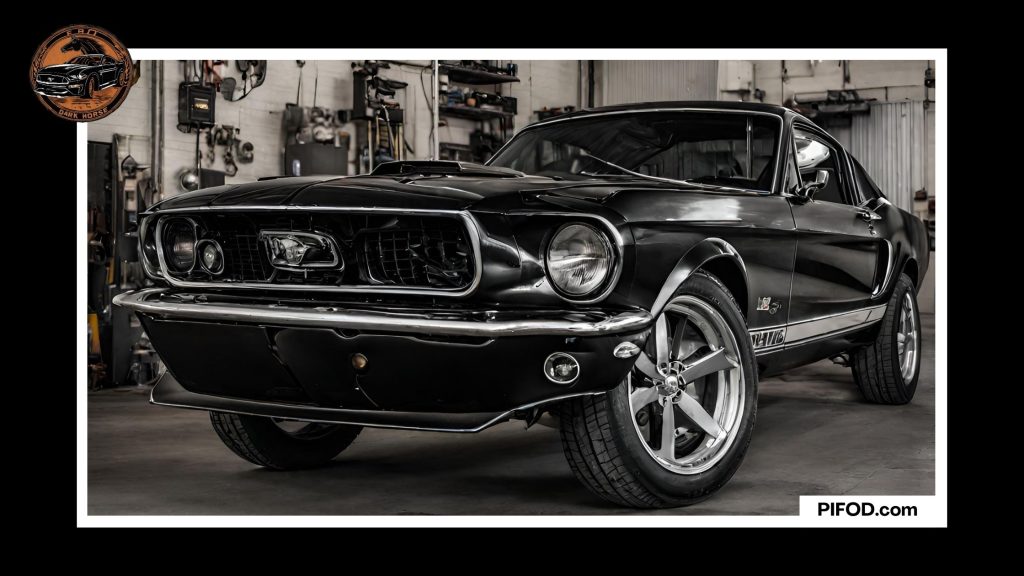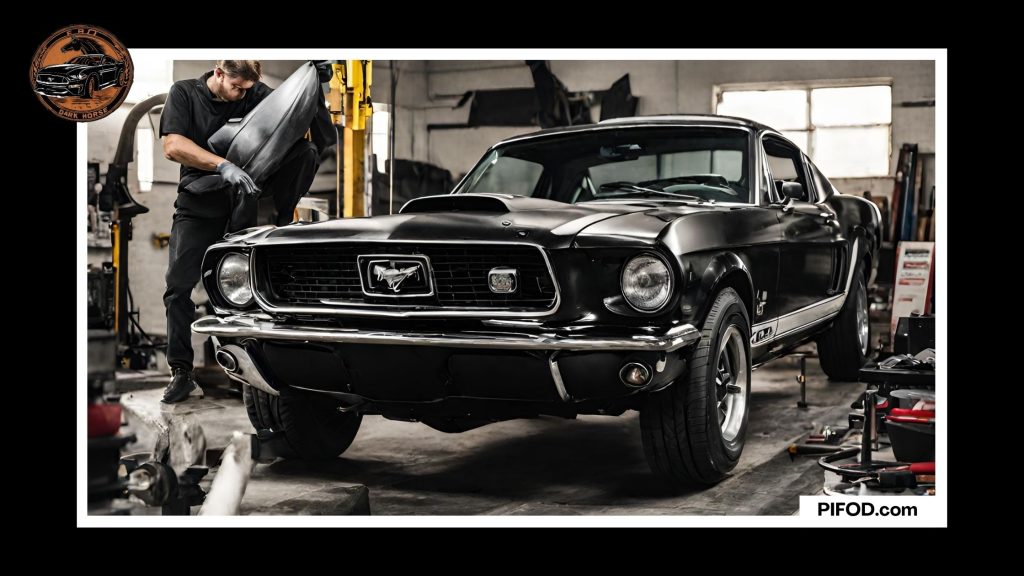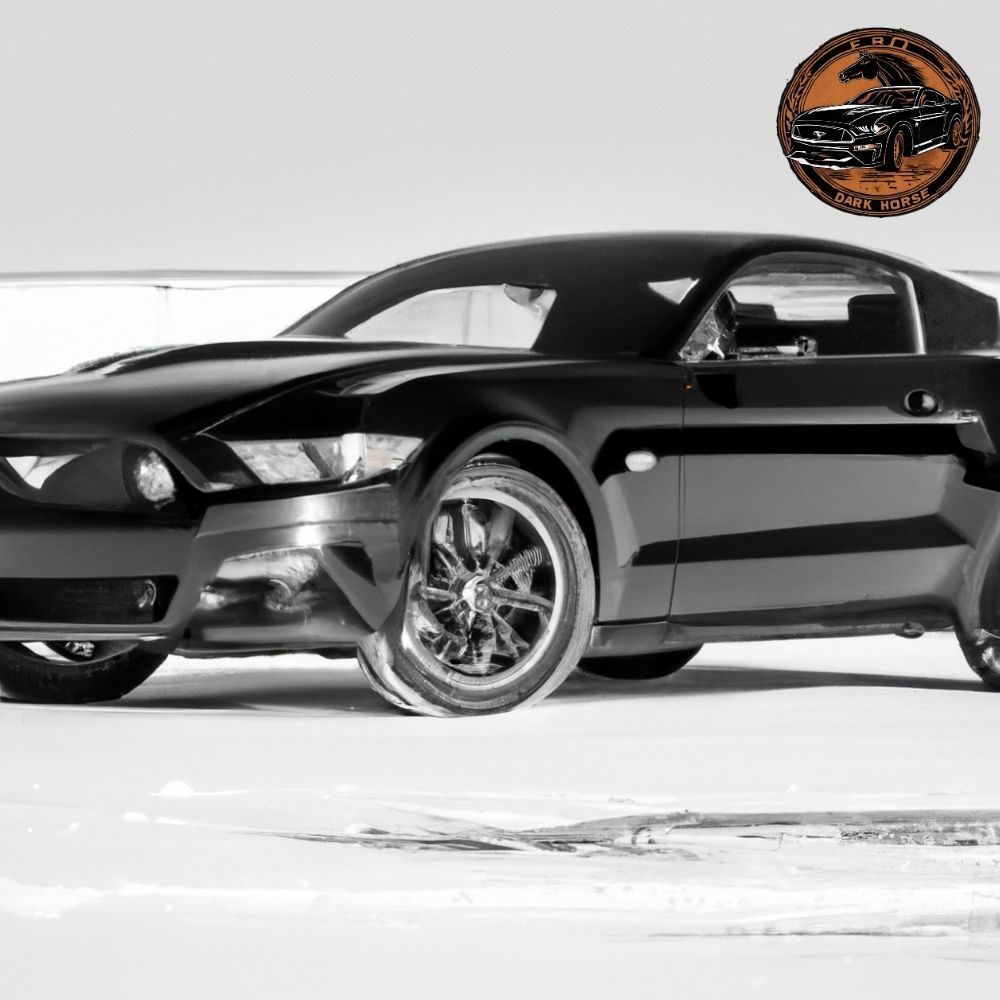The Mustang Dark Horse, an epitome of American muscle and automotive artistry, stands as a symbol of power, speed, and style. As proud owners of this legendary machine, it’s imperative to ensure that it continues to roar down the open road and captivate onlookers. The key to achieving this lies in the realm of proper maintenance. In this comprehensive guide, we’ll embark on a journey through the essential steps required to keep your Mustang Dark Horse in peak condition. From routine maintenance to cleaning, troubleshooting common issues, storage, and even upgrades, we’ve got you covered.
So, fasten your seatbelts, and let’s dive into the world of maintaining your Mustang Dark Horse, ensuring that it remains a symbol of power, performance, and your personal style.
Do Mustangs Require A Lot Of Maintenance?

Mustangs, like most cars, require routine maintenance to ensure they perform reliably and efficiently. Whether a Mustang requires a lot of maintenance depends on various factors, including the specific model, its age, how it’s driven, and how well it’s cared for. Here are some key points to consider:
- Routine Maintenance: Mustangs, like any other vehicle, require regular maintenance such as oil changes, tire rotations, brake inspections, and fluid checks. Following the manufacturer’s recommended maintenance schedule is essential to keep the car in good condition.
- Performance Models: High-performance Mustangs, such as the Shelby GT350 or GT500, may require more intensive maintenance due to their powerful engines and specialized components. These models may demand more frequent attention to engine and suspension components.
- Age and Mileage: Older Mustangs with higher mileage might require more maintenance, as wear and tear on various components can lead to issues. It’s crucial to address aging parts and systems promptly.
- Driving Habits: Aggressive driving, such as frequent hard acceleration and braking, can put extra stress on a Mustang and lead to more rapid wear and tear, necessitating more maintenance.
- Aftermarket Modifications: If the Mustang has aftermarket modifications, such as engine upgrades or suspension enhancements, it may require additional maintenance to ensure these modifications continue to function properly.
- Storage and Seasonal Changes: Properly storing a Mustang during the off-season, especially in cold or wet climates, can reduce the likelihood of maintenance issues arising from neglect and exposure to the elements.
In summary, while Mustangs do require routine maintenance like any other vehicle, the level of maintenance needed can vary. With regular care, adherence to recommended service intervals, and responsible driving habits, you can keep your Mustang in excellent condition without requiring excessive maintenance. Proper maintenance not only ensures the car’s performance but also preserves its value and extends its lifespan.
What Maintenance Does A Mustang Need?
Maintaining a Mustang involves several key maintenance tasks to ensure it continues to perform at its best and remains in top condition. Here’s a list of essential maintenance tasks that a Mustang typically requires:

- Oil Changes: Regular oil changes are IMPORTANT. Follow the manufacturer’s recommendations for the oil type and change intervals, typically every 3,000 to 5,000 miles.
- Tire Care: Proper tire maintenance includes checking and maintaining the correct tire pressure, rotating tires regularly, and ensuring they have sufficient tread depth. Proper tire care enhances safety and performance.
- Brake Maintenance: Regular brake inspections are essential. This includes checking the condition of brake pads, rotors, and brake fluid levels. Replace worn brake components as needed to maintain braking performance.
- Air Filter Replacement: The air filter should be checked and replaced as necessary. A clean air filter ensures proper air intake for the engine, optimizing performance and fuel efficiency.
- Cooling System Maintenance: Check the cooling system, including the radiator and hoses, to prevent overheating. Ensure the coolant is at the correct level and mix for the climate.
- Suspension and Steering: Inspect the suspension components, including shocks, struts, and steering system for signs of wear. Replace worn components to maintain handling and ride comfort.
- Battery Care: Keep the battery terminals clean, and ensure the battery is in good condition. Consider using a battery maintainer, especially during long periods of inactivity.
- Alignment and Balancing: Regularly check and adjust the wheel alignment and balance to ensure even tire wear and proper handling.
- Exhaust System Inspection: Monitor the exhaust system for signs of damage or rust, and address any issues to maintain performance and minimize emissions.
- Regular Cleaning and Detailing: Regularly clean and detail your Mustang’s exterior and interior to preserve its appearance and protect the paint and interior materials.
- Storage and Winterization: Properly store your Mustang during off-seasons, including changing the oil, adding fuel stabilizer, and taking precautions to prevent flat spots on tires.
- Safety Equipment Checks: Ensure that all safety equipment, including seatbelts and airbags, is in working order. Address any issues promptly.
- Check Engine Light: If the check engine light is illuminated, promptly diagnose and address the issue to prevent more extensive problems.
- Scheduled Maintenance: Pay attention to the manufacturer’s recommended maintenance. This schedule provides guidance on when specific services and inspections are required.
Regular maintenance is essential to keep your Mustang in peak condition and extend its lifespan. It’s important to adhere to the recommended service intervals and address issues as soon as they arise to prevent costly repairs down the road.
What Is The Break In Period For The Dark Horse Mustang?

The break-in period for a Dark Horse Mustang, like many high-performance vehicles, is crucial to ensure the long-term health and performance of the engine and other components. During the break-in period, you want to treat your new car with care to allow all the moving parts to settle in properly. While specific guidelines may vary depending on the model and the manufacturer, here are some general recommendations for a typical break-in period for a Dark Horse Mustang:
- First 1,000 Miles: During the initial 1,000 miles (or as specified in your owner’s manual), it’s generally advisable to avoid heavy acceleration and high-speed driving. Drive at moderate speeds and avoid quick starts and hard stops. This allows the engine components to seat properly.
- Vary Your Speeds: It’s important to vary your driving speeds during the break-in period. Avoid long periods of highway driving at a constant speed. The goal is to create a variety of operating conditions for the engine.
- Avoid Excessive Revving: Limit the engine’s RPM (revolutions per minute) to a reasonable range. Avoid excessive high RPMs, especially in the lower gears. This prevents undue stress on the engine.
- Gradual Increase in Performance: As you approach the end of the break-in period, you can gradually start to increase your driving intensity. You can begin to experience the Mustang’s performance capabilities, but still, avoid full-throttle acceleration and high-speed runs.
- Regular Maintenance: Perform regular maintenance during the break-in period, such as oil changes and inspections, as specified in your owner’s manual.
- Careful Engine Warm-Up: Allow the engine to warm up properly before driving, especially in cold weather. This helps with proper lubrication and reduces wear on cold engine components.
It’s important to note that the specific break-in recommendations can vary from one model to another, so always consult your Dark Horse Mustang’s owner’s manual for the manufacturer’s guidelines. Following these break-in guidelines is essential to ensure the longevity, performance, and reliability of your high-performance vehicle. It’s an investment in the long-term health of your Mustang, allowing you to fully enjoy its power and capabilities for years to come.
How Often Should You Change Transmission Fluid Mustang?

The frequency of changing the transmission fluid in your Mustang depends on the type of transmission it has, whether it’s an automatic or manual transmission, and your driving habits. Here are some general guidelines for how often you should change the transmission fluid in a Mustang:
- Automatic Transmission:
- For modern Mustangs with automatic transmissions, it’s common to change the transmission fluid and filter every 30,000 to 60,000 miles, or approximately every 2 to 4 years.
- However, if you frequently engage in heavy towing, aggressive driving, or live in a particularly hot climate, it may be a good idea to change the fluid more frequently, around every 30,000 miles.
- Manual Transmission:
- A general guideline is to change the manual transmission fluid every 60,000 to 90,000 miles.
- Again, if you engage in demanding driving conditions, it’s a good idea to perform this service more often, around every 30,000 to 60,000 miles.
- Severe Driving Conditions:
- If you often drive under severe conditions, such as stop-and-go city traffic, frequent towing, or racing, consider changing the transmission fluid more frequently. In such cases, you might opt for a fluid change every 30,000 miles.
- Check the Owner’s Manual:
- Always refer to your Mustang’s owner’s manual for manufacturer-specific recommendations on transmission fluid change intervals. They might have specific guidelines that you should follow to maintain your vehicle’s warranty.
- Fluid Quality and Color:
- In addition to following mileage and time intervals, pay attention to the condition of the transmission fluid. If the fluid appears dirty, discolored, or has a burnt odor, it’s an indication that it needs to be changed regardless of the mileage.
Remember that proper transmission maintenance is crucial to ensure the longevity and smooth operation of your Mustang’s transmission. Neglecting transmission fluid changes can lead to premature wear, poor performance, and potentially expensive repairs. Always follow the manufacturer’s recommendations, and if you have any doubts or specific concerns about your vehicle, consult with a certified mechanic or dealership service center for expert advice.
How Long Will A Mustang Engine Last?
The lifespan of a Mustang engine can vary significantly depending on several factors, including the model, the type of engine, maintenance, driving habits, and environmental conditions. With proper care and maintenance, a Mustang engine can last well beyond 100,000 miles. Here are some factors that influence engine longevity:

- Maintenance: Regular and consistent maintenance is critical for engine longevity. This includes timely oil changes, air filter replacements, cooling system maintenance, and other routine service tasks. Proper maintenance prevents wear and tear, reduces the risk of damage, and extends the engine’s life.
- Driving Habits: Aggressive driving, such as hard acceleration, frequent high-speed driving, and excessive idling, can accelerate engine wear and shorten its lifespan. Gentle driving and adherence to speed limits are gentler on the engine.
- Type of Engine: The specific engine in your Mustang can influence its longevity. High-performance engines may experience more stress and wear and may not last as long as standard engines. The type of materials used in the engine components also plays a role.
- Environmental Conditions: Extreme weather conditions, such as very hot or very cold climates, can affect engine performance and longevity. Harsh environmental conditions can lead to premature engine wear and issues.
- Maintenance History: A well-documented maintenance history, including regular servicing by certified technicians, can enhance engine longevity. Regular inspections can catch issues early, preventing them from becoming severe problems.
- Aftermarket Modifications: Aftermarket modifications can impact engine longevity, both positively and negatively. Some modifications may enhance performance but increase wear and tear. Properly executed modifications that don’t compromise reliability can extend the engine’s life.
- Transmission and Drivetrain: The health of the transmission and drivetrain components can affect engine longevity. Issues with the transmission or drivetrain can lead to engine stress and increased wear.
- Vehicle Mileage: While mileage is not the sole indicator of engine life, lower-mileage vehicles tend to have less engine wear. However, it’s essential to consider the overall condition and maintenance history of the vehicle.
In summary, there is no fixed number of miles that guarantee how long a Mustang engine will last. The lifespan of the engine depends on a combination of the factors mentioned above. With proper care, regular maintenance, and responsible driving habits, many Mustang engines can last well over 100,000 miles and even beyond. Ultimately, diligent upkeep and attention to potential issues are key to maximizing the longevity of your Mustang’s engine.
Regular Maintenance Schedule
Regular maintenance is the lifeblood of your Mustang Dark Horse. It ensures that your prized possession continues to deliver the thrilling experience you’ve come to expect. Let’s delve into the crucial aspects of maintaining your Mustang Dark Horse.
Oil Change and Filter Replacement

The heart of your Dark Horse resides in its engine, and a well-maintained engine is vital for optimal performance. Follow the manufacturer’s recommended oil change intervals, typically falling between every 3,000 to 5,000 miles. This is more than just an oil change; it’s an elixir that keeps your engine in peak condition. Remember to get new oil filter for each oil change. The filter is your engine’s guardian, ensuring that the oil flowing through it is free from contaminants. Regular filter replacement guarantees clean and efficient lubrication for your engine.
Tire Care
Tires are the interface between your Mustang Dark Horse and the road, making tire care paramount for safety and performance. Regularly check your tire pressure to ensure it matches the recommended levels outlined in your owner’s manual. Proper tire pressure not only enhances fuel efficiency but also contributes to a smoother ride and better handling. To extend the lifespan of your tires and ensure even wear, it’s crucial to rotate them as recommended by the manufacturer. This simple yet effective step can save you money on premature tire replacements and maintain the stability of your ride.
Brake System Maintenance
Safety is non-negotiable when it comes to your Mustang Dark Horse. The brake system is your last line of defense, and its maintenance is essential. Regularly inspect the brake pads, rotors, and brake fluid levels. Worn-out brake pads compromise braking performance and safety, so be vigilant. When the time comes, replace them promptly. Additionally, have your brake fluid flushed as needed. Brake fluid absorbs moisture over time, which can lead to a spongy brake pedal and reduced stopping power. Properly maintained brake fluid ensures that your Dark Horse responds as you would expect it to, providing peace of mind on the road.
Regular maintenance is not just a chore; it’s an investment in the longevity and performance of your Mustang Dark Horse. These steps, when carried out diligently, ensure that your ride remains a symbol of power and style on every journey. So, let’s continue our maintenance journey to preserve the beauty and functionality of your beloved Mustang Dark Horse.
Cleaning and Detailing
Taking care of your Mustang Dark Horse’s appearance is not just about aesthetics; it’s about preserving its essence and protecting its value. In this section, we’ll explore the art of cleaning and detailing to ensure your Dark Horse always looks as stunning as it performs.
Exterior Care

Your Mustang Dark Horse’s exterior is the first thing the world sees, and keeping it clean is essential. Regularly washing and waxing your car not only enhances its appearance but also provides a protective shield against the elements. Here are some tips to ensure your Dark Horse gleams on the road:
- Wash Regularly: Clean your car using a high-quality car wash shampoo and a soft sponge or mitt. Avoid harsh brushes, as they can scratch the paint.
- Wax On: Apply a good car wax to protect the paint and give your Dark Horse that glossy finish. Waxing also makes it easier to remove bugs and road grime.
- Bug Removal: Bugs can be tough to remove, especially after a long road trip. Soak a cloth in warm, soapy water and gently rub to remove bugs without damaging the paint.
- Microfiber Magic: When drying your car, use a microfiber cloth to prevent swirl marks and scratches. Microfiber is gentle on the paint and highly absorbent.
Interior Care
A clean and well-maintained interior not only enhances your driving experience but also contributes to the overall comfort and appeal of your Mustang Dark Horse. Here’s how to keep the inside looking its best:
- Vacuum Regularly: Dust, dirt, and debris can accumulate quickly. Use a vacuum with attachments to clean carpets and seats thoroughly.
- Proper Cleaning: Different materials in your car require specific cleaners. Use appropriate cleaners for the dashboard, leather seats, and fabric upholstery.
- Leather Love: If your Mustang Dark Horse has leather seats, remember to condition the leather. This prevents cracking and keeps it supple and comfortable.
- Air Fresheners: Maintain a fresh and inviting scent inside your car by using air fresheners. Choose scents that resonate with your style.
Regular cleaning and detailing not only protect your investment but also make every drive in your Mustang Dark Horse a more enjoyable experience. Your car is not just a machine; it’s an extension of your personality and style. So, let’s ensure it always reflects your unique taste and attention to detail.
Troubleshooting Common Issues
Even the most well-maintained Mustang Dark Horse can encounter issues from time to time. Don’t panic; many of these problems can be diagnosed and resolved without professional help.
Engine Problems
Your Mustang Dark Horse’s engine is the heart of the beast, and when issues arise, it can be concerning. Here are some common engine-related problems and steps to address them:
- Rough Idling: If your Dark Horse idles roughly or stalls, it might be due to dirty fuel injectors, a malfunctioning sensor, or a clogged air filter. Start by checking the air filter and replacing it if necessary. If the problem persists, it’s advisable to have the fuel injectors and sensors inspected.
- Reduced Power: A noticeable drop in power can be caused by various factors, including a clogged fuel filter, a malfunctioning fuel pump, or a faulty ignition system. Begin by checking the fuel filter, and if it’s clogged, replace it.
- Strange Noises: Unusual noises from the engine can be an early warning sign of trouble. Knocking or pinging sounds may indicate issues with the fuel or ignition system. Squealing sounds could be due to a worn-out serpentine belt.
Electrical Issues
Modern vehicles like the Mustang Dark Horse rely heavily on electrical systems. When electrical issues arise, they can be complex. Here are some common electrical problems and what to do:
- Dead Battery: If your car won’t start and the battery is dead, jump-start it using jumper cables and a second vehicle or a jump starter kit. After jump-starting, it’s essential to investigate why the battery died in the first place. It might be a faulty alternator or a parasitic drain.
- Faulty Lights: Malfunctioning lights, such as headlights, taillights, or turn signals, can be dangerous. Check the corresponding fuses and bulbs. If these components are in working order, it might be an electrical issue that requires professional diagnosis.
- Electrical Gremlins: If you experience intermittent electrical issues, such as power windows not working or sporadic dashboard warning lights, it could be due to loose connections or damaged wires. Carefully inspect and reseat connections, or consult a professional if needed.
Remember that it’s crucial to stay vigilant and address problems promptly. By troubleshooting and resolving common problems early, you can keep your Mustang Dark Horse running smoothly and maintain its legendary performance.
Storage and Winterizing
Whether it’s the end of the driving season or you’re facing a cold winter, proper storage and winterizing can make a significant difference in your Mustang Dark Horse’s condition when it’s time to hit the road again. Let’s delve into the steps for storage and winterizing.
- Clean and Protect: Before storing your Dark Horse, give it a thorough cleaning, just as you would for regular maintenance. This step is crucial because any dirt or contaminants left on the vehicle can cause damage over time. After cleaning, consider applying a layer of wax to protect the paint during storage.
- Change the Oil: If your Dark Horse will be in storage for an extended period, it’s a good idea to change the oil and oil filter before storage. Fresh oil minimizes the risk of contaminants and moisture buildup during the idle period.
- Fuel Stabilization: To prevent fuel system issues, add a fuel stabilizer to the gas tank and run the engine for a few minutes to circulate the stabilized fuel. This prevents the fuel from breaking down and causing problems like clogged injectors.
- Tire Care: Over-inflate the tires slightly to prevent flat spots from developing during extended periods of inactivity. Place the vehicle on jack stands to reduce the weight on the tires.
- Battery Maintenance: Disconnect the car battery or use a battery maintainer to prevent it from discharging completely during storage. A fully discharged battery can freeze and become permanently damaged.
- Climate-Controlled Storage: If possible, store your Dark Horse in a climate-controlled environment. This minimizes temperature and humidity fluctuations, which can be harmful to the car’s components.
- Covering: Use a breathable, high-quality car cover to protect your Mustang Dark Horse from dust and potential damage. Ensure the cover is secure and doesn’t flap in the wind, which can cause scratches.
- Regular Checkups: Even in storage, it’s wise to visit your vehicle periodically to check for any issues or signs of problems. Start the engine briefly to circulate fluids and maintain moving parts.
Winterizing your Mustang Dark Horse is a proactive measure that helps to preserve its condition and performance during the off-season. By following these steps, you’ll ensure that when the warm weather returns or it’s time to hit the road again, your Dark Horse is ready to roar.
Upgrades and Modifications
While the Mustang Dark Horse is a force to be reckoned with straight from the factory, some enthusiasts can’t resist the temptation to enhance its performance and style. In this section, we’ll explore some popular upgrades and modifications that can take your Dark Horse to the next level.
Exhaust System Upgrades
- Cat-Back Exhaust: Upgrading to a cat-back exhaust system can provide a more aggressive exhaust note and a slight boost in horsepower. It’s a relatively straightforward modification that can be done with basic tools.
- Headers: Installing aftermarket headers can improve exhaust flow and contribute to power gains. They come in various materials, including stainless steel and ceramic-coated options.
- Axle-Back Exhaust: If you want to fine-tune the exhaust sound, an axle-back exhaust system is a less invasive option. It typically focuses on the rear mufflers and tailpipes, giving you more control over the tone.
Suspension Modifications
- Lowering Springs: Lowering your Dark Horse with aftermarket springs can enhance its stance and improve handling. It’s a popular choice for those who want a more aggressive look and feel.
- Sway Bars: Upgrading sway bars can reduce body roll during cornering, providing better stability and handling. It’s a modification that enhances performance on the track.
- Shocks and Struts: High-performance shocks and struts can improve ride comfort and handling, especially if you’ve made other suspension modifications.
- Wheel and Tire Upgrades: Upgrading to larger wheels and performance tires not only changes the look of your Mustang but also enhances grip and cornering ability.
- Brake Upgrades: If you’re looking to improve stopping power, consider upgrading your brake system with larger rotors and high-performance brake pads.
When making upgrades and modifications, it’s essential to do thorough research, consider your goals, and work with professionals or experienced enthusiasts who can guide you through the process. Keep in mind that some modifications may affect your warranty, so consult your owner’s manual and the manufacturer’s guidelines to ensure you don’t compromise your coverage.
The Mustang Dark Horse is a canvas waiting for your personal touch. With the right upgrades and modifications, you can create a unique and thrilling driving experience that perfectly suits your style and preferences. So, let’s explore the endless possibilities to make your Dark Horse truly your own.
Safety Tips
While the Mustang Dark Horse offers exhilarating power and performance, it’s important to prioritize safety on the road. Here are some safety tips to ensure that your thrilling rides remain enjoyable and incident-free.
- Regular Maintenance: We’ve discussed maintenance extensively in this guide, but it bears repeating. Regular maintenance not only ensures your Mustang Dark Horse’s performance but also keeps it safe. Regularly inspect and maintain the brakes, tires, and other critical components.
- Tire Care: Proper tire maintenance is paramount for safety. Maintain the recommended tire pressure, and check for tire wear and damage regularly. Replace tires when they reach the end of their lifespan.
- Drive Responsibly: The power of the Dark Horse can be tempting, but always adhere to speed limits and traffic rules. Reckless driving not only endangers your life but also the lives of others on the road.
- Weather Awareness: Be especially cautious in adverse weather conditions. Rain, snow, and ice can drastically affect your car’s handling. Adjust your driving style and reduce speed in such conditions.
- Avoid Distracted Driving: Distracted driving is a significant safety hazard. Put away your phone and other distractions while driving, and focus on the road.
- Seatbelts: Always wear your seatbelt, and ensure that all passengers do the same. Seatbelts are a primary safety feature that can prevent serious injuries in accidents.
- Antilock Brakes: Learn how to use your car’s antilock braking system (ABS). In emergency braking situations, press the brake pedal firmly and maintain steady pressure.
- Electronic Stability Control (ESC): Understand how your car’s ESC works. It can help you maintain control in slippery conditions or during sudden maneuvers.
- Visibility: Keep your windshield, mirrors, and lights clean and in good condition. Proper visibility is crucial for safe driving.
- Child Safety: If you have children in the car, ensure they are in appropriate child safety seats or booster seats, depending on their age and size.
- Defensive Driving: Always be aware of other drivers and anticipate their actions. Defensive driving can help you avoid accidents caused by the negligence of others.
- Emergency Kit: Keep an emergency kit in your car, including items like a flashlight, first aid supplies, jumper cables, and a roadside assistance kit.
Safety should always be the top priority when driving your Mustang Dark Horse. Enjoy the power and excitement it offers, but do so responsibly and with a keen focus on safety. By following these safety tips, you can continue to enjoy your car while protecting yourself and others on the road.
Conclusion
Your Mustang Dark Horse is more than just a car; it’s an icon, a symbol of power, and an expression of your style. To keep it roaring down the open road, captivating onlookers, and performing at its best, proper maintenance is key. This guide has walked you through essential maintenance tasks, from regular care and troubleshooting to upgrades and safety tips. Remember that the journey of maintaining your Dark Horse is ongoing, and by following these guidelines, you’ll ensure that it remains a true legend on the road.
If you have any questions or need further assistance, please refer to the FAQs below or consult your owner’s manual. And, as always, enjoy the exhilarating ride that your Mustang Dark Horse provides.
FAQs
1. How often should I change the oil in my Mustang Dark Horse?
The recommended oil change interval for your Dark Horse typically falls between every 3,000 to 5,000 miles. However, it’s best to follow the specific guidance provided in your owner’s manual.
2. Can I perform basic maintenance tasks, like changing the oil and air filter, on my own?
Yes, many basic maintenance tasks can be performed by DIY enthusiasts. However, if you’re not experienced, it’s advisable to consult your owner’s manual or seek guidance from professionals.
3. What’s the best way to store my Mustang Dark Horse during the winter months?
When storing your car during the winter, make sure it’s clean and protected. Change the oil, add a fuel stabilizer, overinflate the tires slightly, and disconnect the battery or use a maintainer. It’s also advisable to store it in a climate-controlled environment.
4. Are there any recommended safety upgrades for the Mustang Dark Horse?
While the Mustang Dark Horse is already equipped with many safety features, some drivers choose to add options like blind-spot monitoring, adaptive cruise control, and lane-keeping assistance for added safety.
5. How can I maintain the leather interior in my Mustang Dark Horse?
To maintain the leather interior, clean it with a leather-specific cleaner and conditioner. Regularly clean and condition the leather to prevent cracks and keep it soft and supple.
Your Mustang Dark Horse is more than just a car; it’s a symbol of power and style. By following this maintenance guide and these frequently asked questions, you’ll ensure that it continues to provide the thrilling experience you expect while keeping you safe on the road.







